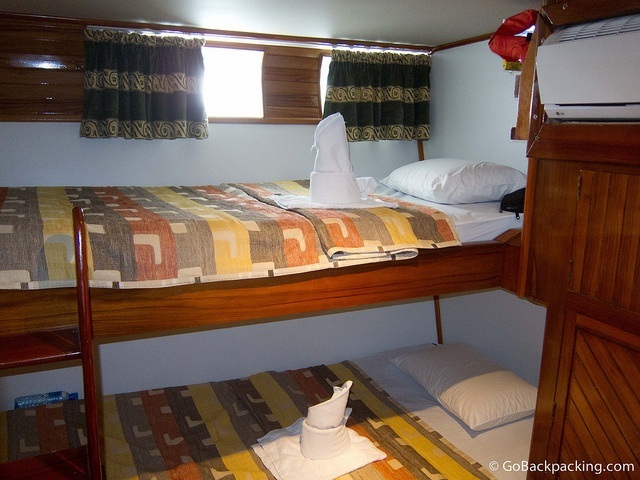
My cabin in the Estrella del Mar
Lauren, one of my 20-something cruisemates in the Galapagos, mentioned she had trouble finding a packing list online before the trip. While I found quite a few through Google, I wanted to add my own 2-cents.
For backpackers, the packing list for the Galapagos Islands will vary little from what you typically carry. And whether you plan to do land-based trips, or live on a yacht for a week, the items you'll carry are the same.
For those travelers who are not used to packing light, a cruise-based trip is a good time to start. Pictured above is my double cabin on the Estrella del Mar, a typical 1st Class motor yacht.
To the right you can catch a faint glimpse of the storage space for two people. Beyond these small closets, there's little space aside from your bed to place belongings. If you're aboard a Deluxe or Luxury yacht, of course you can expect to have a little more space.
Recommended Clothing
- Bathing suit(s) / board shorts
- Long (convertible) lightweight pants
- Several t-shirts, or tank tops for the ladies
- Long sleeve shirt for sun protection, and evenings
- Hoody, sweatshirt, or sweater for evenings (it can be especially chilly at night if you're above deck and the boat is moving)
- Underwear (I recommend Ex Officio)
- Socks (I recommend SmartWool)
- Hat, scarf, bandanna, or any other form of sun protection
- Windbreaker
I wore almost the same clothes every day of my 8-day cruise.
During the day, it was board shorts and one of two t-shirts. At night, I changed into lightweight cargo pants, a cleaner (nights only) t-shirt, and my lightweight, Go Lite hoody.
Recommended Footwear
Regarding footwear, there are two types of landings you'll make when visiting the islands from a boat: dry landings, and wet landings.
Dry landings are exactly that — you can expect to step off the panga (dingy) onto dry land, usually in the form of concrete steps, or a dock.
Wet landings occur when you disembark directly on a beach, and have to get your feet wet (no higher than your knees).
- Teva-style sandals (easiest all-around option), or
- Flip flops
- Sneakers, or hiking shoes with a thick sole (for walking on volcanic rocks)
If you're a Teva kinda guy or gal, you can get by on a typical week long cruise with nothing else. Many people chose this approach on my cruise.
For those who prefer a little sun protection for their feet, or support on hikes (which are often no more than an hour or two at a time), bring sneakers or hiking shoes.
Miscellaneous
- Daypack for carrying stuff on visits to the various beaches and islands
- Full bottle of sunblock (strong SPF)
- Sunglasses
- Motion sickness pills (don't depend on the boat to have them, although some carry a small supply)
- Camera, and related equipment (ex: memory cards, bag, lenses, tripod)
- LED headlamp (for walking through an underground lava tube)
Optional
- Personal snorkel equipment
- Personal diving equipment
- Underwater camera and/or casing
- Binoculars
- MP3 Player
- Kindle, or paperback book(s) for downtime
- Water bottle (boats will supply passengers with a single 500ml plastic bottle which can be refilled on board)
If you're particular about your snorkel equipment (either mask or fins), bring your own, otherwise most boats will supply them (sometimes at an extra cost) and they're easy enough to rent from shops on the islands.
All the boats will supply passengers with towels, both for showers on board, as well as for the beach and snorkeling.
If you're primary reason for visiting Ecuador is a trip to the Galapagos, and you'll be in Quito for a night on the way in or out, remember to pack cold weather clothing (jeans, fleece) as the 2,800-meter altitude ensures chilly nights.
Dave is the Founder and Editor in Chief of Go Backpacking and Feastio. He's been to 66 countries and lived in Colombia and Peru. Read the full story of how he became a travel blogger.
Planning a trip? Go Backpacking recommends:
- G Adventures for small group tours.
- Hostelworld for booking hostels.

Pam
Thursday 17th of November 2011
Is a wetsuit recommended for snorkeling? Is so, how thick? I've heard everything from none to 5 mm. Water temps? We're leaving in a couple of weeks. Thanks.
Dave
Friday 18th of November 2011
Hi Pam, the warm water season runs from December to June, so you may not need a wetsuit for snorkeling.
Usually once you arrive on the islands, you can easily decide whether to rent a wetsuit -- whether you're taking a cruise based trip (they offer the first day to fit you for one) or doing land based trips.
Here's a chart with the average air and water temps per month.
And you can see my complete guide to booking last minute cruises here.
Jess Jones
Wednesday 12th of October 2011
And perfect timing! Cheers Dave! Were you able to leave your big bag at a hostel on the mainland? Or better yet, is there a place to leave it on one of the islands? I think I will be departing/arriving the mainland from different cities.... Thanks again! Very thorough post!
Dave
Wednesday 12th of October 2011
I think you'd be better off taking your belongings, assuming you aren't traveling with a ton of unnecessary stuff.
Personally, I don't feel comfortable leaving stuff in hostels if I don't have to, and even the smallest boats should have sufficient space.